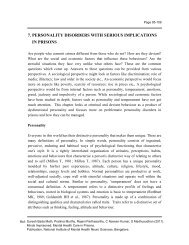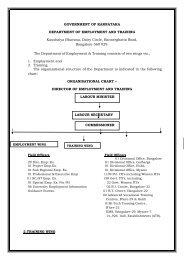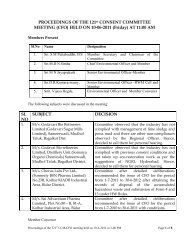Tsunami Disaster - Psychosocial Care for Children [PDF] - Nimhans
Tsunami Disaster - Psychosocial Care for Children [PDF] - Nimhans
Tsunami Disaster - Psychosocial Care for Children [PDF] - Nimhans
You also want an ePaper? Increase the reach of your titles
YUMPU automatically turns print PDFs into web optimized ePapers that Google loves.
ARTWORKAt the start, let the child know that the drawing or artwork is <strong>for</strong> them and will not be judgedby you. This helps children who are not good at art also join in freely. Once the children havefinished their task, invite them to talk one by one about the picture that they have drawn. Allow themto talk about what they have drawn and do not pass any good or bad comment. Do not bejudgmental. Seek clarifications if you do not understand something.The child’s painting may something that still concerns them (flooded home, significantindividuals in his/her life, stressful place or events). This brief insight into the child’s world may be asign of a specific area where some help may be needed. Artwork can be done repeatedly usingdifferent mediums and themes to explore the child’s world. Various materials like paint, crayons,chalk and blackboard, sketch pens or the whole hand painting or finger paints can be used.CLAY WORKThe main advantage of using clay as a medium is that children can express their feelings veryeffectively through clay. Things can be made and destroyed and remade again. <strong>Children</strong> can give anidea about the things that they have lost and the process of creating it is greater than the actual endproduct. During their creation process, they are able to think about the loss and later during asharing round they can talk about it and bring out their feelings. Some children may not even talk butthe process of making that model would have released some of their emotions.USE OF STORYTELLING/DRAMA/PUPPETRYThere is a two-fold benefit of storytelling. The adult can use a story to pass on a message toa child and a child can be encouraged to tell a story to get an insight into his/her world. The storycould be fictional or something from his/her own life.Use some issues that come up during these sessions as matter to develop a story that teachesthe child something positive. For instance, the story can be that of a child who coped with a scarysituation effectively. As a child listens to the story, he/she will be able to relate that to his/her own life.Provide the basic ingredients of the story-characters, location, event, and then give fewminutes to think about what the people will do in such a situation. Ask the child to tell a story basedon the given characters, location and the situation. Use questions to get a better understanding incase there are some gaps. You can also do this as a group activity. Storytelling is an effectivemedium to talk about frightening issues without upsetting the child. For small children, it is moreinteresting than talking. Also children derive a lot of fun.Storytelling can also be done using mediums like dolls, toy animals or puppets to expressfeelings. <strong>Children</strong> find it easier to ventilate when some medium is used. Once the problem isexpressed it becomes much easier to address. It can be done with one child or can be done with agroup of children. Generate discussions and follow it up.TOT INFORMATION MANUAL - 1 49


![Tsunami Disaster - Psychosocial Care for Children [PDF] - Nimhans](https://img.yumpu.com/43739531/49/500x640/tsunami-disaster-psychosocial-care-for-children-pdf-nimhans.jpg)














